Matthew Day Jackson explores an ambitious hybrid fusion of art, science, and technology in his multi-media exhibition entitled, Capture, on view at Hauser and Wirth. The biological underbelly of life’s undeniable dark side is richly expressed in sculpture, framed wall works, and digital photography, where themes of dehumanization mediated by technological interventions create a hyper-tense subtext. The artist systematically explores and catalogues the inevitable, inexorable metamorphosis of living beings, as their evolution towards disintegration marches from phase to phase in a process of constant flux. The striking metaphysical implications of the works, while semi-submerged in technical applications, are nonetheless a strong feature of the show’s content.
Jackson investigates the correspondences between human anatomical forms and botanicals, exhibiting in linear succession the visually similar structures of human hand bones, networks of veins, and tree root systems. Trophy, a collaborative piece created with Swedish forensic scientist Oscar Nilsson, demonstrates a telling sequence of Jackson’s silicone heads, as they morph loosely from skeleton, to brain, to fossilized ridges, and finally to a system of tree roots.
The work highlights our transition from a distinct flesh and blood personality to anonymous, calcified biological matter. It comprises a visual paraphrase of the traditional phrase used at burials, “ashes to ashes, dust to dust…” The bodies, veins, nerves, muscles and skeletons presented individually in glass cases are reminiscent of the glass vitrines employed in the film Independence Day to house the captured alien invaders for scientific observation. The skeletons of several Egyptian Pharaohs are on display for the curious, and with a similar callousness, in the Museum of Antiquities in Cairo.
Jackson seems to regard Earth’s territory and rock formations as imbued with a mystical intelligence; the view of Yosemite Valley, juxtaposed with an enlarged replicated Chinese Scholar’s Stone, transmits the message that Earth and man are linked in invisible but irrepressible ways. The darker side of the artist’s view excludes any romantic references to Nature’s cycles of night and day or to the rhythmic changing of the seasons. In the piece Inside/Outside (Quartered) he seems to view humanity as a waning life form, as he explores murky inner bodily systems, encompassed in shadow, that evoke broken tree roots as much as they resemble human veins. The attributes he retains in view are only slivers of flesh, strands of hair, nipples, or mere glimpses of visible features. There is a harsh side to his vision, as the examples of humanity’s inner and outer manifestations, seen within glass vitrines, are pierced with spikes like St. Sebastian. The apocalypse in Jackson’s schema is in progress; it may be too late, but he delves into layer upon layer of the human skull, seemingly driven to contemplate the inner mechanisms for clues that illuminate a creature that is out to annihilate his own species. In the digital c-print entitled Me, Dead at 39, Jackson’s body, wrapped in a dark shroud, is affixed with rope to a tree limb. This wrenching piece exposes the artist’s desolation, his hopeless view as in death he finally connects with a nature whose existence he sees to be as imperiled as he is.
The artist links a modern adaptation of Michelangelo’s Pieta (comprised of a chunk of concrete aggregate) to his reeling sense of the world and its inhabitants imperiled, already over-the-top toward doom. There is a sad flickering hope for the kind of redemption symbolized in Mary’s figure as she cradles Christ’s crucified body. Jackson’s morbidity finds expression in the flaming ambiguous sky of the multi-media wall work, Looking into Yosemite Valley, where the sky-form expresses the glow of rampant wild fires, more than it conveys the conclusion of a scenic rosy sunset. In the large-scale motorized c-print entitled We, Us, Them, the viewer longs to see each landscape view, not sequentially presented by a mechanical device, but as separate discrete images, each worth the time it would take to contemplate the view at length.
Jackson’s sense of destitution and loss spills out into the multi-media wall works August 6, 1945, and Farside (burnt wood) that focus respectively on the blackened earth after a nuclear holocaust has decimated it, and the most distant realm trodden by man, the surface of the moon. These works reach beyond the average person’s level of existential angst. They combine an individual’s trepidations with death’s legacy of genetic decay and fears that resonate with our presently endangered existence on the Earth itself. Jackson’s musings include the possible subjugation of the remains of the human race in an unthinkable scenario of horrifying captivity and certain annihilation. The artist’s vision evokes the existentialists Albert Camus and Jean-Paul Sartre, whose books The Plague and Nausea, respectively, resonate with a similarly uncompromising world, showing only a passing glimmer of hope that in death there might remotely be a chance of resurrection. Jackson’s questing, risk-taking nature, coupled with a “kid in a candy shop” enthusiasm for technological experiments, provides a challenging subtext. The artist informs these ambitious works with wide ranging complexities that speak of confounding multiple meanings.
By Mary Hrbacek
























